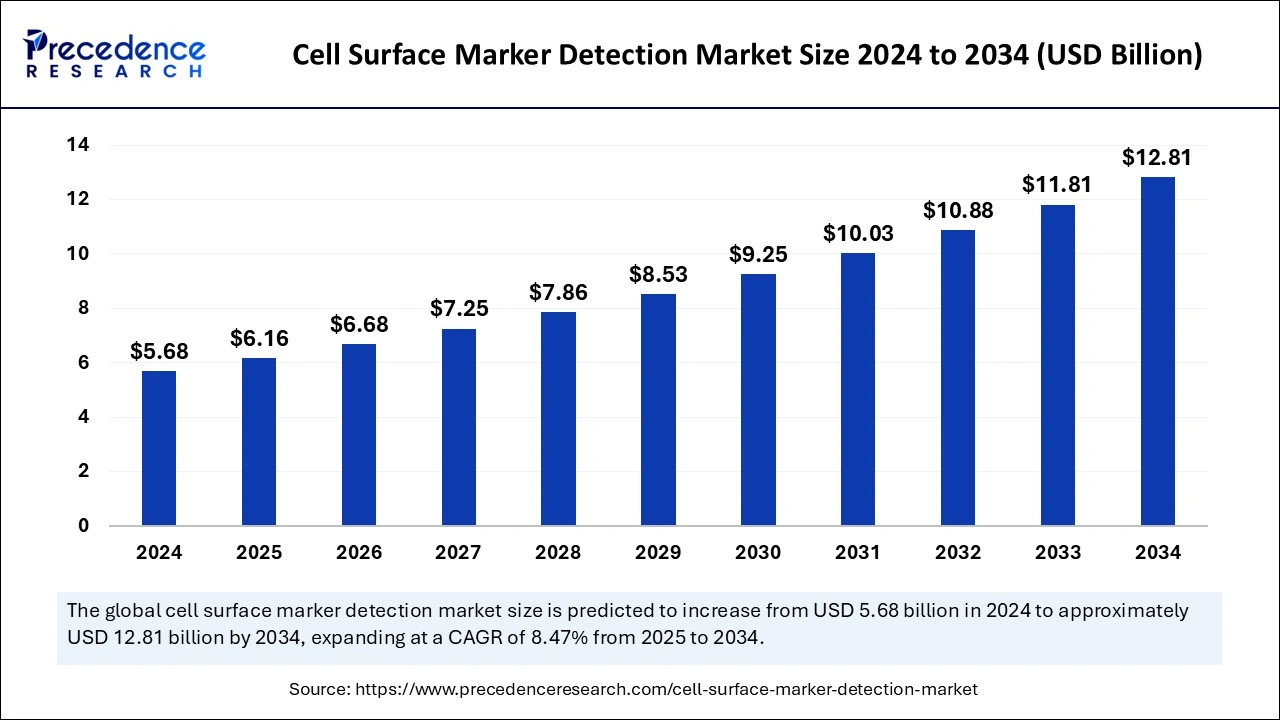Cell Surface Marker Detection Market to Reach USD 12.81 Bn by 2034
The global cell surface marker detection market is projected to grow from USD 5.68 billion in 2024 to USD 12.81 billion by 2034, at a CAGR of 8.47%

Cell Surface Marker Detection Market Key Takeaways
In 2024, North America led the market with the largest share of 40%.
Asia Pacific is anticipated to register the highest CAGR of 8.73% throughout the forecast period.
The reagents and kits segment accounted for the largest market share of 65% by product in 2024.
The hematology analyzers segment is projected to grow at a CAGR of 8.3% over the forecast period.
By application, the disease diagnosis and identification segment dominated the market with a 52% share in 2024.
The research and drug discovery segment is expected to witness rapid growth during the forecast period.
Cell Surface Marker Detection Market Overview
The cell surface marker detection market is witnessing significant growth, driven by the increasing demand for precision medicine and advancements in biotechnology. Cell surface markers are essential components in immunology, oncology, and stem cell research, as they help identify and classify different cell types based on their protein expression.
The market includes various detection technologies, such as flow cytometry, PCR, and immunoassays, which are widely used in clinical diagnostics and drug development. With the rising prevalence of chronic diseases such as cancer and autoimmune disorders, the need for accurate and efficient cell surface marker detection methods has surged.
Technological advancements, coupled with the growing emphasis on targeted therapies, are further propelling market expansion.
Cell Surface Marker Detection Market Drivers
One of the primary drivers of the cell surface marker detection market is the increasing focus on personalized medicine, where targeted therapies are designed based on an individual’s genetic and cellular profile. The growing prevalence of cancer and infectious diseases has led to a higher demand for advanced diagnostic tools that can provide precise cellular identification.
The expansion of research in immunology and stem cell therapy is also contributing to market growth, as scientists rely on cell surface markers to study immune responses and cell differentiation. Furthermore, technological advancements in flow cytometry and multiplex assays have enhanced the sensitivity and specificity of detection methods, allowing for more accurate and high-throughput analysis of cell populations.
Cell Surface Marker Detection Market Opportunities
The integration of artificial intelligence and automation in cell surface marker detection presents significant opportunities for market growth. Automated flow cytometry and AI-driven image analysis are revolutionizing the field by improving data accuracy and reducing manual intervention.
Additionally, the rising adoption of single-cell analysis techniques is creating new opportunities for understanding cellular heterogeneity, particularly in cancer research. The growing focus on point-of-care diagnostics and lab-on-a-chip technologies is also expected to drive demand for rapid and portable detection methods. Emerging markets in Asia-Pacific and Latin America, where healthcare infrastructure is expanding, offer new avenues for companies looking to establish a presence in the cell surface marker detection sector.
Cell Surface Marker Detection Market Challenges
Despite its growth potential, the market faces several challenges, including high costs associated with advanced detection technologies and the need for specialized expertise to interpret complex data. The standardization of cell surface marker assays remains a challenge, as variations in protocols and reagents can affect reproducibility and comparability of results.
Regulatory hurdles related to the approval of diagnostic assays and medical devices also pose a barrier to market entry. Moreover, limited awareness and accessibility to advanced detection technologies in low-resource settings hinder market expansion in developing regions.
Cell Surface Marker Detection Market Regional Insights
North America dominates the cell surface marker detection market, driven by strong investments in biomedical research, well-established healthcare infrastructure, and the presence of key industry players. Europe follows closely, with significant research funding and collaborations between academic institutions and pharmaceutical companies.
The Asia-Pacific region is witnessing rapid growth due to increasing healthcare expenditure, rising cancer incidence, and government initiatives to promote biotechnology research. China, India, and Japan are emerging as key markets for cell surface marker detection technologies.
Latin America and the Middle East are gradually expanding their presence in the market, with improvements in healthcare infrastructure and growing demand for advanced diagnostics.
Cell Surface Marker Detection Market Recent Developments
Recent advancements in single-cell sequencing and high-dimensional flow cytometry have revolutionized the field, enabling deeper insights into cellular behavior and disease progression. Several biotechnology companies have introduced next-generation immunoassays and multiplex detection platforms to enhance the accuracy and efficiency of cell marker analysis.
Collaborations between research institutions and diagnostic companies are leading to the development of novel biomarker panels for early disease detection. Additionally, regulatory agencies are streamlining approval processes for innovative diagnostic technologies, fostering a more dynamic and competitive market environment.
Cell Surface Marker Detection Market Top Companies
- Abbott Laboratories
- Danaher Corporation (Beckman Coulter Inc.)
- Becton, Dickinson, and Company
- Bio Rad Laboratories Inc.
- F. Hoffmann-La Roche Ltd
- Diasorin SpA (Luminex Corporation)
- Nihon Kohden Corporation
- Qiagen NV
- Siemens Healthineers
- Thermo Fisher Scientific Inc.
Segments Covered in the Report
By Product
- Flow Cytometry
- Hematology Analyzers
- Reagents & Kits
By Application
- Disease Diagnosis & Identification
- Research & Drug Discovery
- Others
By Geography
- North America
- Europe, Asia-Pacific
- Latin America
- Middle East
- Africa
